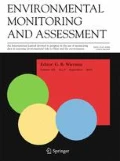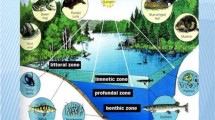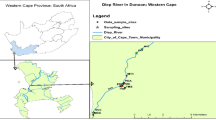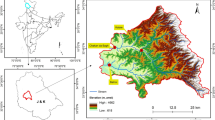Abstract
In order to evaluate the water quality of one of the most polluted urban river in Malaysia, the Penchala River, performance of eight biotic indices, Biomonitoring Working Party (BMWP), BMWPThai, BMWPViet, Average Score Per Taxon (ASPT), ASPTThai, BMWPViet, Family Biotic Index (FBI), and Singapore Biotic Index (SingScore), was compared. The water quality categorization based on these biotic indices was then compared with the categorization of Malaysian Water Quality Index (WQI) derived from measurements of six water physicochemical parameters (pH, BOD, COD, NH3-N, DO, and TSS). The river was divided into four sections: upstream section (recreational area), middle stream 1 (residential area), middle stream 2 (commercial area), and downstream. Abundance and diversity of the macroinvertebrates were the highest in the upstream section (407 individual and H′ = 1.56, respectively), followed by the middle stream 1 (356 individual and H′ = 0.82). The least abundance was recorded in the downstream section (214 individual). Among all biotic indices, BMWP was the most reliable in evaluating the water quality of this urban river as their classifications were comparable to the WQI. BMWPs in this study have strong relationships with dissolved oxygen (DO) content. Our results demonstrated that the biotic indices were more sensitive towards organic pollution than the WQI. BMWP indices especially BMWPViet were the most reliable and could be adopted along with the WQI for assessment of water quality in urban rivers.



Similar content being viewed by others
References
Akmal, M., Mohammad, S. O., Ahmad Abas, K., & Mohamed Nor, M. D. (2013). Monitoring urban river water quality using macroinvertebrate and physico-chemical parameters: case study of Penchala River, Malaysia. Journal of Biological Sciences, 13(6), 474–482.
Alba-Tercedor, J. (1996). Aquatic macroinvertebrates and water quality of rivers. IV Simposio del Agua de Andalucía (SIAGA), 2, 203–213.
Allan, D. A. (1995). Stream ecology: structure and function of running waters. London: Chapman and Hall.
Al-Shami, S., Che Salmah, M. R., Abu Hassan, A., Suhaila, A. H., & Siti Azizah, M. N. (2011). Influence of agricultural, industrial, and anthropogenic stresses on the distribution and diversity of macroinvertebrates in Juru River Basin, Penang, Malaysia. Ecotoxicology & Environmental Safety, 74, 1195–1202.
Al-Shami, S., Che Salmah, M. R., Abu Hassan, A., & Siti Azizah, M. N. (2010). Distribution of Chironomidae (Insecta: Diptera) in polluted rivers of the Juru River Basin, Penang, Malaysia. Journal of Environmental Science, 22(11), 1718–1727.
Al-Shami, S. A., Che Salmah, M. R., Abu Hassan, A., Madziatul Rosmahanie, M., Suhaila, A. H., Wan Mohd Hafezul, W. A. G., Al-Harbi, N. A., & Al-Mutairi K. A. (2017). Biodiversity patterns of aquatic macroinvertebrates in tropical forests streams as a response to logging activities and deforestation. Acta Ecologica Sinica, 37, 332–339.
Armitage, P. D., Moss, M., Wright, J. F., & Furse, M. T. (1983). The performance of a new biological water quality score system based on macroinvertebrates over a wide range of unpolluted running water sites. Water Research, 17(3), 333–347.
Azrina, M. Z., Yap, C. K., Rahim Ismail, A., Ismail, A., & Tan, S. G. (2006). Anthropogenic impacts on the distribution and biodiversity of benthic macroinvertebrates and water quality of the Langat River, Peninsular Malaysia. Ecotoxicology and Environmental Safety, 64(3), 337–347.
Beavan, L., Sadler, J., & Pinder, C. (2001). The invertebrate fauna of a physically modified urban river. Hydrobiologia, 445, 97–108.
Blakely, T. J., Eikaas, H. S., & Harding, J. S. (2014). The Singscore: a macroinvertebrate biotic index for assessing the health of Singapore’s streams and canals. Raffles Bulletin of Zoology, 62, 540–548.
Brinkhurst, R. O., & Jamieson, B. G. M. (1971). Aquatic Oligochaeta of the world. Toronto: University of Toronto Press.
Capitulo, A. R., Tangorra, M., & Ocon, C. (2001). Use of benthic macroinvertebrates to assess the biological status of Pampean streams in Argentina. Aquatic Ecology, 35, 109–119.
Che Salmah, M. R., Abu Hassan, A., & Jongkar, G. (2007). Diversity of Ephemeroptera, Plecoptera and Trichoptera in various tributaries of Temenggor catchment, Perak, Malaysia. Wetland Science, 5(1), 20–31.
Chessman, B. C. (2003). New sensitivity grades for Australian river macroinvertebrates. Marine and Freshwater Research, 54, 95–103.
Chow, M. D. (2017). River of life project now 67 pct complete. The News Strait Times. https://www.nst.com.my/news/2017/04/227380/river-life-project-now-67-pct-complete. Accessed 1 July 2017.
Clifford, T., & Tariro, D. (2005). Land-use impacts on river water quality in lowveld sand river systems in south-east Zimbabwe. Land Use and Water Resources Research, 5, 3.1–3.10.
Connolly, N. M., Crossland, M. R., & Pearson, R. G. (2004). Effect of low dissolved oxygen on survival, emergence, and drift of tropical stream macroinvertebrates. Journal of North American Benthological Society, 23(2), 251–270.
Czerniawska-Kusza, I. (2005). Comparing modified biological monitoring working party score system and several biological indices based on macroinvertebrates for water-quality assessment. Limnologica, 35, 169–176.
De Pauw, N., & Vanhooren, G. (1983). Method for biological quality assessment of watercourses in Belgium. Hydrobiologia, 100, 153–168.
DOE. (1985). Development of Water Quality Criteria and Standards for Malaysia. Kuala Lumpur: Department of Environment.
Dufrene, M., & Legendre, P. (1997). Species assemblages and indicator species: the need for a flexible asymmetrical approach. Ecological Monographs, 67, 345–366.
Faridah, O., Alaa Eldin, M. E., & Ibrahim, M. (2012). Trend analysis of a tropical urban river water quality in Malaysia. Journal of Environmental Monitoring, 14, 3164–3173.
Fazleena, A. (2010). Sg Penchala picked for river rescue project. The Star. http://www.thestar.com.my/news/community/2010/01/06/sg-penchala-picked-for-river-rescue-project/. Accessed July 2017.
GEC (2017). Sungai Penchala river education programme. http://www.gec.org.my/index.cfm?&menuid=298. Accessed 18 May 2017.
Gonçalves, F. B., & Menezes, M. S. (2011). A comparative analysis of biotic indices that use macroinvertebrates to assess water quality in a coastal river of Paraná state, southern Brazil. Biota Neotropica, 11, 27–36.
Gooderham, J., & Tsyrlin, E. (2002). The waterbug book. a guide to the freshwater macroinvertebrates of temperate Australia. Victoria: CSIRO Publishing.
Heino, H., Melo, A. S., Bini, L. M., Altermatt, F., Al-Shami, S. A., Angeler, D., Bonada, N., Brand, C., Callisto, M., Cottenie, K., Dangles, O., Dudgeon, D., Encalada, A., Göthe, E., Grönroos, M., Hamada, N., Jacobsen, D., Landeiro, V. L., Ligeiro, R., Martins, R. T., Miserendino, M. L., Md Rawi, C. S., Rodrigues, M., Roque, F. O., Sandin, L., Schmera, D., Sgarbi, L. F., Simaika, J., Siqueira, T., Thompson, R. M., & Townsend, C. R. (2015). A comparative analysis reveals weak relationships between ecological factors and beta diversity of stream insect meta-communities at two spatial levels. Ecology and Evolution, 5, 1235–1248.
Hilsenhoff, W. L. (1988). Rapid field assessment of organic pollution with a family-level biotic index. Journal of the North American Benthological Society, 7(1), 65–68.
Hoang, T. T. H. (2009). Monitoring and assessment of macroinvertebrates communities in support of river management in northern Vietnam. Unpublished Ph.D Thesis. Ghent University, Belgium.
Hynes, H. B. N. (1970). The ecology of running waters. Toronto: University of Toronto Press.
Jäch, M. A., & Ji, L. (2003). Water beetles of China (Vol. III). Vienna: Zoologisch-Botanische Gesellschaft & Wiener Coleopterologenverein.
Jäch, M. A., & Ji, L. (1998). Water beetles of China (Vol. II). Vienna: Zoologisch-Botanische Gesellschaft & Wiener Coleopterologenverein.
Jiang, J., Wen, F., Ma, Y. P., & Yan, Y. (2009). Community structure of macrozoobentos and bioassessment of water quality in Hujiaxi Stream of Qingjiang River Basin, Hubei Province. Journal of Lake Sciences, 21, 547–555. https://doi.org/10.18307/2009.0414.
Jian-Guo, J. (2006). Development of a new biotic index to assess freshwater pollution. Environmental Pollution, 139, 306–317.
Joshi, Y. K., Tortajada, C., & Biswas, A. K. (2012). Cleaning of the Singapore River and Kallang Basin in Singapore: human and environmental dimensions. Ambio, 41, 777–781.
Kalyoncu, H., & Zeybek, M. (2011). An application of different biotic and diversity indices for assessing water quality: a case study in the Rivers Cukurca and Isparta (Turkey). African Journal of Agricultural Research, 6, 19–27.
Koutsomitrou, D., Efthimiou, G., Detsis, V., & Economou-Amilli, A. (2014). Ecological assessment of the Kifisos River channel and the riparian forest vegetation. 2nd International Conference - Water resources and wetlands. https://www.limnology.ro/water2014/proceedings/11_Dimitra.pdf. Accessed 1 July 2017.
Lafont, M. (1984). Oligochaete communities as biological descriptors of pollution in the fine sediments of rivers. Hydrobiologia, 115(1), 127–129.
Lenat, D. R., & Penrose, D. L. (1996). History of the EPT taxa richness metric. Bulletin North American Benthological Society, 12(13), 279–290.
Leunda, P. M., Oscoz, J., Miranda, R., & Ariño, A. H. (2009). Longitudinal and seasonal variation of the benthic macroinvertebrate community and biotic indices in an undisturbed Pyrenean river. Ecological Indicators, 9, 52–63.
Linke, S., Norris, R. H., Faith, D. P., & Stockwell, D. (2005). ANNA: a new prediction method for bioassessment programs. Freshwater Biology, 50, 147–158.
Martins, R. T., Stephan, N. N. C., & Alves, R. G. (2008). Tubificidae (Annelida: Oligochaeta) as an indicator of water quality in an urban stream in southeast Brazil. Acta Limnologica Brasiliensia, 20(3), 221–226.
Metcalfe, J. L. (1989). Biological water quality assessment of running waters based on macroinvertebrate communities: history and present status in Europe. Environmental Pollution, 60, 101–139.
Merritt, R. W., Cummins, K. W., & Berg, M. B. (2008). An introduction to the aquatic insects of North America (4th ed.). Iowa: Kendall/Hunt Publishing Company.
MMD (2007). Iklim Malaysia. Malaysia Meteorology Department, Malaysia. http://www.met.gov.my/web/metmalaysia/118. Accessed 18 March 2017.
Murphy, P. M. (1978). The temporal variability in biotic indices. Environment Pollution, 13, 227–236.
Mustow, S. E. (2002). Biological monitoring of rivers in Thailand: use and adaptation of the BMWP score. Hydrobiologia, 479, 191–229.
Mustow, S. E. (1997). Aquatic macroinvertebrates and environmental quality of rivers in Northern Thailand. Unpublished PhD thesis, London University, London.
Nessimian, J. L., Venticinque, E. M., Zuanon, J., De Marco Jr., P., Gordo, M., Fidelis, L., Batista, J. D., & Juen, L. (2008). Land use, habitat integrity, and aquatic insect assemblages in Central Amazonian streams. Hydrobiologia, 614, 117–131.
Nguyen, X. Q., Mai, D. Y., Pinder, C., & Tilling, S. (2004). Biological surveillance of freshwaters: a practical manual and identification key for use in Vietnam. Hanoi: Vietnam National University Publishers.
Normile, D. (2010). Restoration or devastation? Science, 327(5973), 1568–1570.
Pennak, B. W. (1978). Freshwater invertebrate of the United States. New York: Litton Educational Publishing Inc.
Plafkin, J. L., Barbour, M. T., Porter, K., Gross, S., & Hughes, R. M. (1989). Rapid bioassessment protocols for use in streams and rivers: benthic macroinvertebrates and fish. Washington, D.C.: EPA.
Ravera, O. (2001). A comparison between diversity, similarity and biotic indices applied to the macroinvertebrate community of a small stream: the Ravella river (Como Province, Northern Italy). Aquatic Ecology, 35(2), 97–107.
Rossaro, B., Boggero, A., Lods Crozet, B., Free, G., Lencioni, V., & Marziali, L. (2011). A comparison of different biotic indices based on benthic macroinvertebrates in Italian lakes. Journal of Limnology, 70, 109–122.
Salman, A. A., Che Salmah, M. R., Abu Hassan, A., Madziatul Rosemahanie, M., & Al Mutairi, K. (2014). Importance of regional diversity and environmental conditions on local species richness of aquatic macro-invertebrates in tropical forested streams. Journal of Tropical Ecology, 30(4), 335–346.
Sangpradup, N., & Boonsoong, B. (2006). Identification of freshwater invertebrates of the Mekong River and its tributaries. Vientiane: Mekong River Commission.
Semenchenko, V. P., & Moroz, M. D. (2005). Comparative analysis of biotic indices in the monitoring system of running water in a biospheric reserve. Water Resources, 32, 200–203.
Simić, V., & Simić, S. (1999). Use of the rivers macroinvertebrates of Serbia to formulate a biotic index. Hydrobiologia, 416, 51–64.
Simpson, J. C., & Norris, R. H. (2000). Biological assessment of river quality: development of AUSRIVAS models and outputs. In Wright J. F., Sutcliffe D. W., & Furse M. T. (Eds.), Assessing the biological quality of fresh waters: RIVPACS and other techniques (pp. 125–142). United Kingdom: Freshwater Biological Association.
Suhaila, A. H., Che Salmah, M. R., & Nurul Huda, A. (2014). Seasonal abundance and diversity of aquatic insects in rivers in Gunung Jerai Forest Reserve, Malaysia. Sains Malaysiana, 43(5), 667–674.
Thorp, J. H., & Covich, A. P. (1991). Ecology and classification of North American freshwater invertebrates. San Diego, California: Academic Press Inc.
Voelz, N. J., Zuellig, R. E., Shieh, S. H., & Ward, J. V. (2005). The effects of urban areas on benthic macroinvertebrates in two Colorado plains rivers. Environmental Monitoring and Assessment, 101, 175–202.
Vörösmarty, C. J., McIntyre, P. B., Gessner, M. O., Dudgeon, D., & Prusevich, A. (2010). Global threats to human water security and river biodiversity. Nature, 467(7315), 555–561.
Wallace, J. B., Grubaugh, J. W., & Whiles, M. R. (1996). Biotic indices and stream ecosystem processes: results from and experimental study. Ecological Applications, 6, 140–151.
Wan Mohd Hafezul, W. A. G., Che Salmah, M. R., Suhaila, A. H., Salman, A. A., Abu Hassan, A., & Ahmad Najmi, N. H. (2016). Variation in environmental conditions influences diversity and abundance of Ephemeroptera in forest streams of northern Peninsula Malaysia. Tropical Ecology, 57(3), 489–501.
Wright, J. F. (1995). Development and use of a system for predicting the macroinvertebrate fauna in flowing waters. Australian Journal of Ecology, 20, 181–197.
Yule, C. M., & Yong, H. S. (2004). Freshwater invertebrates of the Malaysian regions. Kuala Lumpur: Academy of Sciences Malaysia.
Zaki, Z. (2010). Benchmarking river water quality in Malaysia. Jurutera. http://irep.iium.edu.my/2954/1/Feature-BenchmarkingRiverWater3pp.pdf. Accessed 20 May 2017.
Zamora-Munõz, C., Sainz-Cantero, C. E., Sanchez-Ortega, A., & Alba-Tercedor, J. (1995). Are biological indices BMPW’ and ASPT’ and their significance regarding water quality seasonally dependent? Factors explaining their variations. Water Research, 29, 285–290.
Zamora-Munõz, C., & Alba-Tercedor, J. (1996). Bioassessment of organically polluted Spanish rivers, using a biotic index and multivariate methods. Journal of the North American Benthological Society, 15, 332–352.
Zubaidah, I., Rahizah, S., & Ramlee, K. (2014). Evaluating trends of water quality index of selected Kelang river tributaries. Environmental Engineering and Management Journal, 13(1), 61–72.
Acknowledgements
The authors wish to thank the School of Environmental Science and Natural Resources who provide the technical supports and laboratory to make this study possible.
Funding
The authors acknowledge the financial support for this project provided by the Ministry of Higher Education under a Long-Term Research Grant Scheme (203/PKT/6720004).
Author information
Authors and Affiliations
Corresponding author
Rights and permissions
About this article
Cite this article
Wan Abdul Ghani, W.M.H., Abas Kutty, A., Mahazar, M.A. et al. Performance of biotic indices in comparison to chemical-based Water Quality Index (WQI) in evaluating the water quality of urban river. Environ Monit Assess 190, 297 (2018). https://doi.org/10.1007/s10661-018-6675-6
Received:
Accepted:
Published:
DOI: https://doi.org/10.1007/s10661-018-6675-6




